#fearsome critter
Text
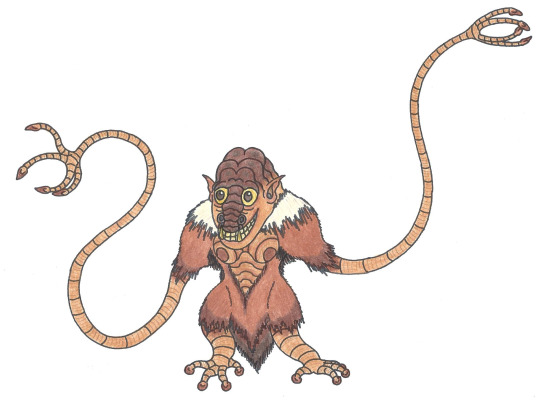
Those who live around the great conifer forests know this resident well, either from the hoots and hollers that can be heard through the canopy, or from the lumps on their head from previous encounters with this temperamental species. The agropelter is the arboreal ape of the north, living atop the pines and making sure no one forgets that. While some would say that they are famous for their bizarre boneless limbs and elastic reach, their real infamy comes from what they do with them. At this point, everyone on the continent should know that agropelters are extremely territorial, and do not take kindly to larger beasts wandering below their tree top homes. Those that intrude will hear angry hooting coming from up above, and that is your first warning. If you do not turn tail and run at the mere sound of that, the agropelter will give one more chance. What comes shortly after is the sharp cracking sound of splitting wood, like someone just snapped off a tree branch. It sounds like that because it is that, as the agropelter starts grabbing tree limbs and ripping them off. That noise is the last warning you get, as what follows is the ape opening fire. While agropelters have weaker limbs compared to other primates, they make up for it by whipping their arms with extreme speed and force. Some compare it to a whip, others see it like an atlatl, but no matter the comparison, the agropelter has one hell of a baseball pitch. When it throws its woody projectiles, it does so with enough force to crack bone and leave splinters in the flesh. They launch as many missiles as they need until the intruder is either gone or dead. And if they run out of branches? Well, that doesn't bother them, as they will just grab anything in reach and fire away. They can use pine cones, chunks of bark or even bird nests to assault the trespasser. During the winter, they may also grab handfuls of ice and snow to launch, starting a one sided snowball fight that can easily result in missing teeth.
When not raging war on any creature that intrudes on their territory, the agropelter swings effortlessly through the conifer canopy in search of food. Agropelters are avivores, with a particular taste for owls and woodpeckers. They may hide in hollow trees in wait for these birds, then lash out with a tendriled arm to snag them. Some have used their incredible throwing power and aim to snipe them from the skies, exploding flying birds into a ball of feathers and then rushing after the falling corpse. These hollow trees aren't only for hunting, but also act as their nests when it is time to sleep and a musical instrument when the breeding season kicks in. This special season only comes every four years, and the forests explode into a cacophony of noise when it happens. Male agropelters snap off tree branches and drum them against their hollow tree trunk, all while adding a serenade of booming hoots and yelps. Females seek out the loudest of them all, which means that sometimes lesser males will team up and attempt to "tone down" the bigger competition. Some males have been found sabotaging tree trunks before the breeding season kicks in, using their arms and weaponry to bust them up and ruin their drumming potential. The bigger males must keep an eye out for these saboteurs, and they unleash a flurry of angry whipping arms at them til they scatter. Those that succeed in winning over a female will soon be father to three or five pups, which will spend their early years hiding in the hollow tree. They will be raised on the mother's milk while the male goes out to fetch birds for them. The young will also dine on owl and woodpecker, and will use the leftover bones to practice their throwing arm. Trees, birds and their siblings will be the target of their aim, but at such an age their throws are harmless.
For the people who lived around these forests, the agropelter was either one of two things. To those who loved the forest as it was, they were the guardians of it. To those who saw the forest as a profit, they were a menace. Agropelters are universally hated by all lumberjacks and loggers, as every job in a conifer forest is dealing with a painful rain of wood and pine cones. Their assaults on logging camps and the axe-wielding men within became so bad, that CTE was listed as the number one condition and death associated with being a lumberjack. Quite a few injuries came to be when some of the loggers decided to fight back, usually in a drunken state. After putting back a few, some of the men would take to throwing beer cans and bottles at the apes, giving them a taste of their own medicine. However, the apes would simply grab these lobbed missiles and do an ol' "return to sender." When doctors found themselves picking glass shards out of a logger's skull, they knew how such a grievous wound came to be.
With the agropelters furiously guarding their domain, many forest loving folk came to believe that these massive pine forests would remain untouched. No logging company would risk the men and insurance costs to chop down these trees, so thus they would be left in peace. Sadly, that is not how things work in this day and age. The agropelters had their powerful throw and arsenal behind them, but at the end of the day, they were still fighting a war with sticks. A man with an axe was no match to that, and a man with a chainsaw fared no better. But when man in armored bulldozers and feller bunchers rolled onto the battlefield, they finally knew defeat. Logging companies fitted their vehicles like they were going to war, with extra armor and bulletproof glass. Some even went literal with it and hired sharpshooters to snipe the apes from the branches. The agropelters gave all they could, but mere sticks and pine cones did little against the unstoppable march of man and his machines. Many agropelter forests were logged, destroying their homes and scaring off their food source. Whenever the owls and woodpeckers left, the agropelters were forced to follow. Plenty of people in the public argued against this destruction and the eviction of these species, but lobbyists and lumber mills had the agropelter's infamy on their side. With those nasty apes gone, now you can hike in what's left of these woods in peace! Aren't you glad you can go for a walk through the pines without getting a concussion? And they eat precious owls and woodpeckers too! Why, if it wasn't for agropelters, we probably would still have the ivory-billed woodpecker around! The notoriety of these apes severely dampened whatever sympathy their fate garnered, and soon their numbers began to fall.
Though many of their habitat were lost, there were still forests left untouched and several pockets of these agropelters left in peace. Protests and legislation halted logging in some places, which added to the number of sanctuaries remaining. Here the agropelter can still remain, though threats to woodpecker and owl populations in general can still mean trouble for them. But these pine forests aren't the only place these apes are found now, as those who lost their homes didn't always lose their lives. When a forest was cleared out to set up residential areas and suburbs, what agropelters remained decided to move right in. Though their hollow trees are now gone, they found something appealing in the shiny lattice transmission towers and electrical poles. The sight of a bunch of dead branches and junk jammed into the center of these hollow towers is confirmation that an agropelter has set up shop. Some have broken into attics and chimneys, trying to make nests there, though the human residents are quick to evict them.
While the owls and woodpeckers have left these areas, these urban agropelters have seemed to develop a taste for different birds, like crows, pigeons and geese. They still have a love for owls, which was an early problem during their settlement when agropelters were tricked by decoy owls people put on their roofs. The excited primate would rush to snag this prized treat, only to find it mere inedible plastic. Depriving them of this joy puts them in a foul mood, which meant lots of property damage. Folk in these areas have banned decoy owls, as the freak out that comes from frustrated agropelters has ruined many roofs, windows and cars. To make matters worse, they have substituted their weaponry as well, since tree branches aren't readily available. Shingles, gutters, bricks, even satellite dishes are launched at people who get too close. Multiple power outages have occurred when power company employees have tried to get rid of nesting agropelters and one of these primates started ripping at the transformers and cables.
One infamous case had an agropelter taking up residence in the local church's steeple. When the church's minister was found brained by the cross that once sat atop the spire, police and animal control were called in to put the beast down. Though the agropelter was eventually shot, the famous photo of a church bell through a police car's windshield was slapped onto every paper in the country.
As of now, the fate of the agropelter seems up in the air. Those that still live in their forest homes may perhaps be safe from what the future brings, but those that still struggle to exist in the land of man may not be so lucky. They fight fiercely, but everyone knows what happens to the animal that dares bite the hand of humanity. Some believe it is only a matter of time before these urban agropelters are wiped out, and the species is kept confined to the pine trees. But some believers hold out the hope that a peace can be brokered, and that the two species can coexist. Despite their reputation, there are certainly people who have a love for the agropelter, and wish them a better fate. Most assume that these people watched the movie "Ed" as children, which was about a baseball loving agropelter. Who couldn't fall in love with Ed's wacky antics and mean pitch? Those who hold this fondness for this movie probably never looked up what happened behind the scenes during the sequel. In hindsight, it was a real dumb idea to let one of these apes near a bucket of real baseballs. You ever hear of that pitcher that killed a bird with his throw? Yeah, Ed has got him pretty beat on pitch speed and body count....
-----------------------------------------------
Lets toss in an ol Fearsome Critter with the crowd. Discussed this one with Lediblock2 !
63 notes
·
View notes
Photo
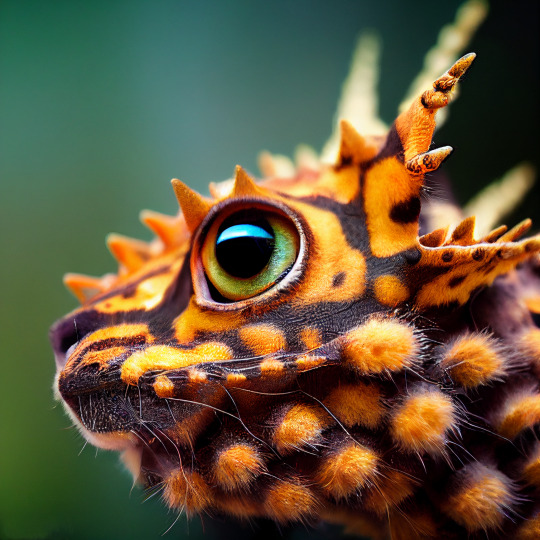
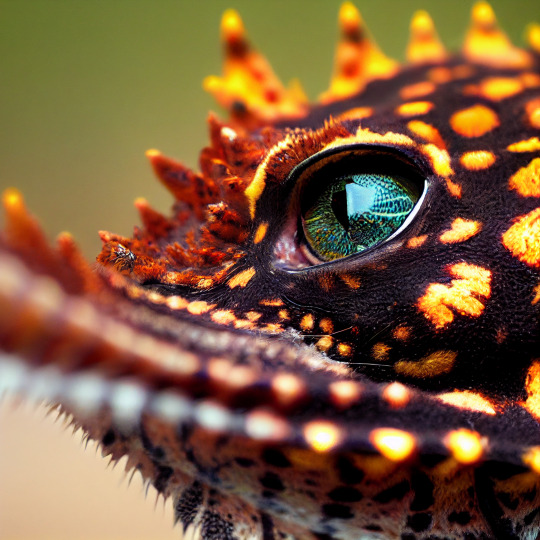
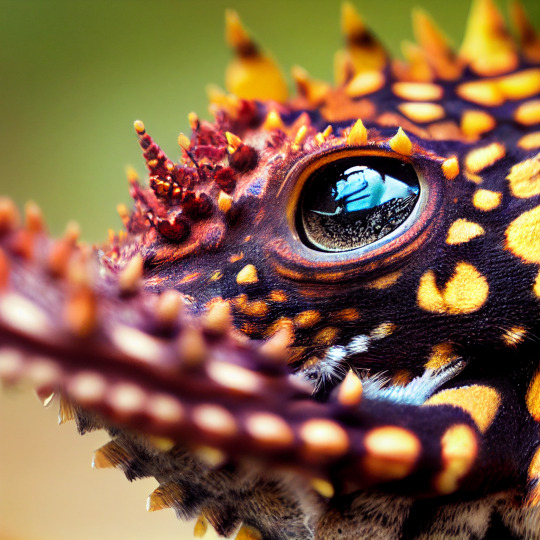

Cactus cats of the American Southwest.
136 notes
·
View notes
Photo

It's a hodag.
Does it look like any previous depictions of hodags? No.Did I reference any particular hodag while drawing it? No.
Why call it a hodag then? Well, look at it. What else would you call that thing?
So long as it's quadrupedal, thorny, horny, toothy, and suitably monstrous, I think you could call it a hodag. Except whatever bastardy Rowling cooked up. If you value your sanity, never look in the Illustrated Edition of Fantastic Beasts and Where to Find Them...
#hodag#fearsome critter#monster#mythical creatures#myth stuff#i didn't buy it fyi#just checked it out at my local library#the hodag is the worst but there's only two or three good creature illustrations in there#way too artsy for what's supposed to be a zoological textbook for kids
94 notes
·
View notes
Text
Day 2: Hoop Snake
(Bit of a shorter one but it helps with the concept. I knew instantly once I saw this prompt that these snakes were gonna race. My main inspiration was the wiener races in Texas where they race dachshunds.)
Welcome one and all to the 200th annual Hoop Snake race! I hope you all brought your popcorn and mice because this race is looking to be a good one. Our last race ended with a tie between Ouroboros and Dwarf Reed that by all accounts seemed impossible to break. After hours of deliberation from our team after the fact, we are finally confident enough to break this scandal. To those who may not have noticed before, Scarlet Scale has a different handler than you’re used to. That’s because she discovered that Wrangler was deliberately sabotaging the race! That’s right folks. He laid a time dilation spell right before the finish line which manipulated the space so that Ouroboros and Dwarf Reed would always tie in a bid to get them disqualified and him as first place. To some of you newcomers here I know it sounds ridiculous, penalizing a demon for cheating. But our snakes here play fair and square, which is why Scarlet Scale has decided to move on to a new handler who will play fair. Everyone, give a big round of applause to Scarlet’s chosen: Joslither! Now with that cleared up, we’re gonna have a great race today! This time hopefully with a real winner.
#cryptidinjuly2023#cryptidinjuly#cryptid#fearsome critter#hoop snake#writing#creative writing#prompt list#writeblr
2 notes
·
View notes
Text

Ancardia's Unusual Animals--the Hugag
Classification: Beast (pachyderm)
Habitat: Deep rainforest and wetlands in the Southern hemisphere.
The Hugag is an unusual smaller pachyderm which dwells primarily in dense, wet forested regions in the Southern hemisphere, noted for its lack of pronounced tusks, prominent long trunk, or great size. It has a few small tusks like those of a domestic pig, and a short trunk which is fairly prehensile but not particularly dexterous, as well as long, shaggy coat of hair over most of its neck, shoulders, rump, and upper limbs while leaving the other parts mostly bare. The relatively harmless hugag is the subject of a number of logging camp superstitions from long ago; legend says it has no knees, and so cutting the tree it leans against while resting renders it helpless—in reality, the hugag, like other animals with bones… has knees, and while maybe disoriented by knocking over a small tree it leaned upon, will be fully able to get to its feet and make hell for the foolish loggers testing such a rumor. It is also falsely believed it has an immense upper lip that prevents it from grazing; in reality, the hugag’s “oversized upper lip” is its tapir-like short trunk, which assists greatly as it browses low limbs of beech, oak, and maple trees.
The hugag lives a mostly solitary life, except for the middle of autumn which is the breeding season, and is a complete herbivore. It is also generally more similar to a rhino than to an elephant, being shy, skittish, and prone to charging only when startled by attacks or loud noises. Adult hugag are roughly the same size as a white rhinoceros in both length and weight, though are about 20 centimeters taller at the shoulder.
#ancardia#ancardian homebrew#bestiary#mixed media#creatures#Ancient Domains of Mystery#ADOM#Dnd-like#pachyderm#Fearsome Critter#lumberjack folklore#hugag
2 notes
·
View notes
Text

Some years ago a lady brought to the Royal Scottish Museum in Edinburgh a trout covered with a fine coat of white fur. It was pleasingly mounted on a wooden shield and was labelled as follows:
FUR BEARING TROUT
Very Rare
Caught while trolling in Lake Superior off Gros Cap, Near Sault Ste. Marie, district of Algoma. It is believed that the great depth and the extreme penetrating coldness of the water in which these fish live has caused them to grow their dense coat of (usually) white fur. Mounted by ROSS C. JOBE, Taxidermist of Sault Ste. Marie, Ont.
Visiting the museum to find out more about her unique fish, the lady was told that it was undoubtedly a trout (either brown or brook) and that its fine white coat was undoubtedly from a rabbit, whereupon she immediately presented the fish to the museum. She had bought this fake in good faith which indicates that the idea of a fur-bearing trout did not seem outlandish to her.
―Stanley Peter Dance, Animal Fakes & Frauds, 1976
#fur bearing trout#fur-bearing trout#fearsome critters#animal fakes & frauds#s peter dance#taxidermy#hoax#royal scottish museum#national museum of scotland#ross c jobe#photographer unknown#popular post
2K notes
·
View notes
Text

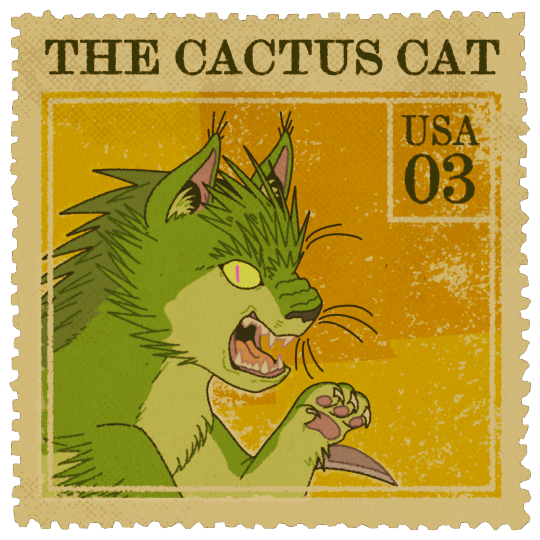
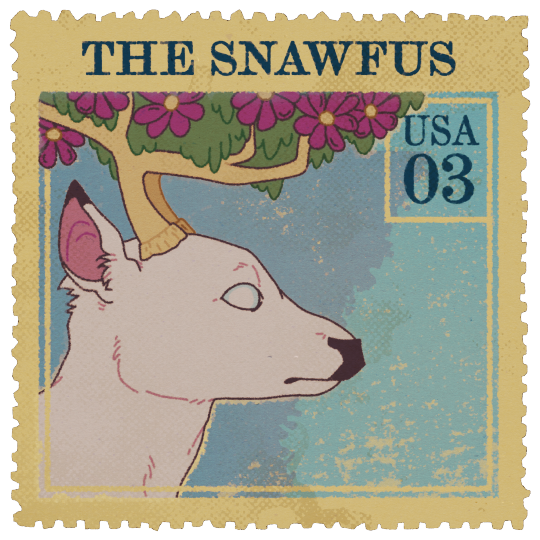
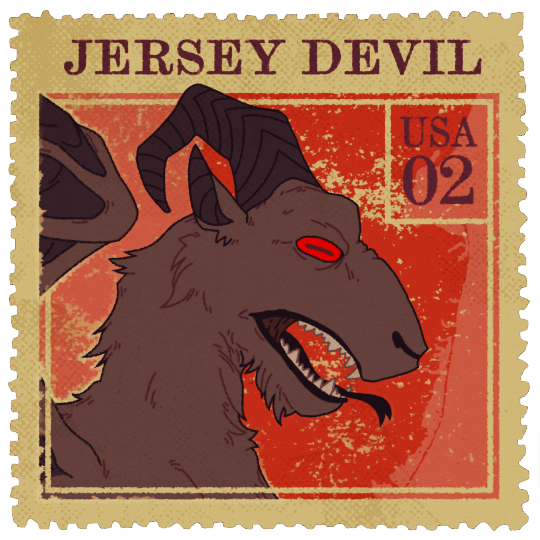





A set of stamps based on various North American cryptids
#illustration#stamps#cryptid#cryptids#cryptid art#fearsome critters#digital art#jackalope#cactus cat#snawfus#jersey devil#hodag#squonk#chupacabra#el chupacabra#snallygaster#fur bearing trout#my art#schoolwork
795 notes
·
View notes
Text
There’s an old lumberjack legend that leprechauns were brought as pets to a logging camp on the Madawaska River, they escaped into the muskeg and now Canada is just full of feral man-eating leprechauns.
And I think about that a lot.
195 notes
·
View notes
Text

Without much doubt, the most famous of all Fearsome Critters. These beasts are well known for their popularity as taxidermy hoaxes subjects.
#BriefBestiary#bestiary#digital art#fantasy#folklore#legend#fearsome critters#jackalope#gooklookus#pedigres leapusalopus ineptus#pedigres leapusalopus#north american legend#north american folklore#taxidermy#douglas wyoming
100 notes
·
View notes
Text
52 notes
·
View notes
Text

Hidebehind, a man-eating fearsome critter that hunted lumberjacks in North America, able to hide perfectly behind anything and from any look
#art#character art#character design#creature design#creature art#cryptid#fearsome critters#horror#forest#dark art
42 notes
·
View notes
Photo

Found in alpine rivers and mountain lakes, the fur-bearing trout has been an important species for northern regions ever since they were first discovered. Natives of these areas valued this species for their warm fur and waterproof skin, which is the same reasons why settlers looked into these fish. With the fur trading business at an all time high, another plentiful source of fur was always welcome. However, this material was originally not as popular as one would imagine. There is some debate on why this came to be, but there are certainly some clear facts to point out. With the fur-bearing trout at a high population in these cold regions, there was plenty of fur to be harvested. The method of catching them was also said to be way easier then conventional trapping, as anyone with a rod and reel could take a crack at hooking one. With the ease of catch and high numbers, it didn't take long for trout fur to flood the market. Some argue that this lowered the prices and value of said fur, which then didn't make it as profitable as a business.
However, some claim it was more of a social thing that caused the fur to be treated as lesser. First of all, this fur was attached to a fish, an animal normally seen as slimy and bottom feeding, so it could be that customers were already turned off from there. Then there is the fact that native tribes of these regions regularly used this fur, and let us not forget the opinions settlers had of these natives. There are plenty of recorded "comments" about these people, and a lot of them were not kind. Pointing out that the "savages" of these lands were so "backwards" that they used "fish fur" was rather common, and many higher up folk would dare not associate with such a thing. Lastly, with the ease of catching, most folk could go to their local river or lake and hook one themselves, resulting in lesser buyers. In short time, the derogatory term of "fish fur" was slapped on this kind of material, as it was mostly seen being worn by natives and poorer folk. It is believed this imagery and these beliefs was why fur-bearing trout were not as popular as one would think.
Time, however, would eventually correct this belief, or perhaps it was more the market that did the adjusting. As beaver, muskrat and other fur-bearing species started to take a heavy hit from the fur trade, trappers needed an alternative. While other pelts grew harder to obtain and more expensive, trout fur remained low in price and easy to obtain. Thus, it suddenly became a popular material, with folks touting its superior warmth and waterproof nature. Natives and other folk who were already using this fur just rolled their eyes at this new development, quite familiar with how these fads worked. Fur-bearing trout continued to be a frequently harvested material, all the way to the decline of the fur trade. Obviously their populations took a big hit, as pressure fell on them to make up for the lack of beaver and such. Thankfully, populations at higher elevations and hard to reach lakes had some protection, and thus remained strong. The fur-bearing trout survived this brutal market, but it certainly wasn't the end of the trout fur.
The fur-bearing trout is still harvested today for its iconic pelt, though regulations have helped keep their populations healthy. Limits and seasons allow this species to still thrive, and it has become the official fish for a couple mountainous states. Locals of these regions still hook them for both food and fur, seeing it as a tradition. Restaurants do serve fillets of these trout, at the expense of hearing the tired joke of "waiter, there is a hair on my fish!" A popular tourist package is taking folk out to remote lakes so they can catch and skin their own trout, which will then be turned into gloves or slippers. Fur-bearing trout also still remains a popular material in the eye of the public, while other furs have been scrutinized or condemned. Fish do not garner the same sympathy from the public as a furry mink or cuddly chinchilla would, so many are fine to turn a blind eye to their harvest. It is why fish farms have begun to spring up in certain regions, to provide more of this species for harvest. Foolish entrepreneurs quickly learned the importance of keeping these fisheries in colder regions, as hot summers and warm water led to heat stroke and disease in their populations.
Even with their efforts, though, there are folk who would go on about the difference between farm raised trout fur and wild caught. For some, the experience of catching your own trout and turning it into garments with your own hands captures the feeling of ruggedness and old timey tradition. All the old anglers in town will tell you that catching and preparing your own fur-bearing trout is a rite of passage, that no one is truly a fisherman til they wear trout fur mitts of their own making. It is unsure of how much a tradition this really is, but the businesses selling this experience are sure to holler that sentiment from the rooftops.
-----------------------------------------------------
Just throwing in something simple and different. Here, enjoy a Fearsome Critter! It's found in cold places, it counts!
18 notes
·
View notes
Text


The Luferlang/Lufferlang is a "fearsome critter" from North American folklore. It was said to be a horse-like creature with triple jointed legs and the ability to kill with a single bite. Because of this, many artists portray the Luferlang as a cross between a horse and a venomous spider.
#the owl house#owl house#toh#the owl house pilot#owl house pilot#toh pilot#luferlang#lufferlang#fearsome critters#luz nuceda#king clawthorne
101 notes
·
View notes
Text
Cryptid of the Week: Splintercat
The splintercat is a nocturnal legendary feline who is said to charge at trees and break them with its hardy head. It originates in North America, in many locations.
Supposedly, splintercats are always in a bad mood because of their tree-breaking habits-- their heads might be hard, but they still get headaches.
The story of splintercats likely originates from the sounds of trees expanding and cracking (and breaking apart) during the winter.
Splintercat creek in Oregon was named after splintercats.
9 notes
·
View notes
Text

Day 6: Our Gang Means Death
#yeehawgust#Ensouled#The boardwalk is home to a whole host of spirits#Most of them are along these lines-- smallish Fearsome Critters performing various acts of gremlinery#Monty is -technically- in charge of the Boardwalk's spirits#but it's more of an ongoing negotiation than a clear command
215 notes
·
View notes
Text
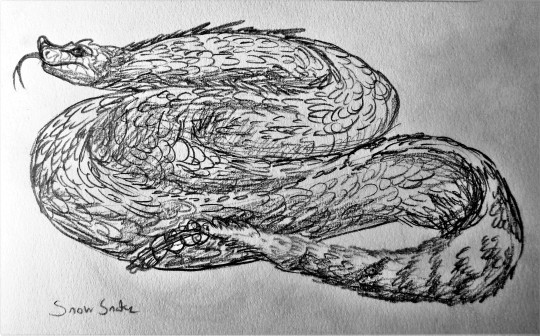
Ancardia's Unusual Animals--the Snow Snake
Classification: Beast (squamate)
Habitat: The grasslands, scrubs and forested regions of Tvearban
A truly unique member of the squamates, the snow snake is one of the few large exothermic reptiles adapted to spend most of its life out and about in the cold reaches of Tvearban. Adults measure approximately 1.5 to 2 meters in length and are the thickness of a human’s wrist (not counting the flared scales). An adult on a sunny day can tolerate temperatures hovering above freezing by making use of the strange adaptation that is its layered, flared scales on the top three quarters of its body, which act as both insulation from heat loss and as biological solar panels which capture the heat of sunlight and transfer it to the blood vessels below the root of each scale, enabling a passive heating as the snow snake travels about. Despite its heating system, it is still usually very sluggish in such cold conditions, and it tends to require cooling off if temperatures in its environment reach over 27 degrees Celsius. In summer months, the snow snake tends to spend much of its time in caves where the air is more tolerable for them, and are noted for being primarily bat-hunters during the short arctic summer. In transitional times when the temperature cools off, the snow snake travels widely, hunting a variety of animals such as lemmings, snow hares, squirrels and occasional birds. In the depths of winter when it drops below freezing, the snow snake employs its signature survival technique of burrowing into snowdrifts to insulate and conserve their heat before entering a torpor state. This state often lasts about three weeks, and in between bouts of this the snow snake will very slowly slither its way around its territory until it has located a cavern site for the spring breeding season; in the weeks leading up to the main thaw, snow snakes have congregated in larger caverns en masse, and will soon form breeding balls.
Snow snakes from the same breeding ball will all lay their eggs in protected crevices communally in the rear portion of the same cavern some two months later before departing for their normal haunts in the springtime. Some of these eggs may be taken by larger carnivorous bats, or cave crickets, or rarely scavenging foxes and birds that make their way into the caves, but the sheer density of them tends to ensure that at least 50% will make it to hatching time. After two months of incubation, the tiny snow snakes emerge and spend their first year exclusively in the caves, as they have not developed the flared scales that enable adults to tolerate the lower temperatures. They primarily feed on small arthropods such as crickets, roaches, and centipedes in this year, and grow from nine-centimeter newborns to 40-centimeter adolescents in this time, growing in their signature scales in their last molt before the next spring. Snow snakes are considered full adults by the end of their second year, and the typical lifespan of a snow snake is between 12 and 20 years. Some predators of the snow snake adults include polar and brown bears, arctic wolves, large eagles, and various local humanoids such as frost giants, hill giants, Islydweragh and northern groups of humans. The shingle-scaled hides are prized by some groups for making windbreakers and hoods that resist the weather and moisture like few other natural materials, and usually are paired with fox or wolf fur to line the interior to maximize the insulation. Snow snake venom is not particularly lethal, though it is still a danger to humanoids that choose to hunt them or who stumble upon one accidentally—though the only known fatalities from snow snake bites have been spelunkers who have slipped into pits containing masses of the juveniles (which led to the young members of this species to once erroneously be thought a different species of “pit viper”).
#ancardia#ancardian homebrew#bestiary#mixed media#creatures#Ancient Domains of Mystery#ADOM#Dnd-like#Fearsome Critter#lumberjack folklore#reptile#snow snake
1 note
·
View note